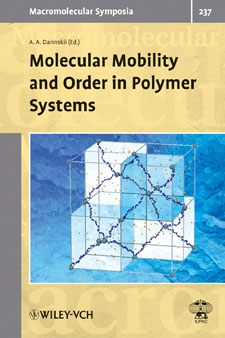|
|
Vol.
28 No. 3
May-June 2006
Molecular Mobility and Order in Polymer Systems
by Anatoly Darinskii
The 5th International
Symposium on Molecular Mobility and Order in Polymer Systems,
sponsored by IUPAC, was held at the Scientists House (the
former Great Duke Vladimir’s Palace) in Saint Petersburg,
Russia, 20–24 June 2005. The palace is located on the
Neva river embankment and is one of the most beautiful in
St. Petersburg. The symposium was organized by the Department
of Chemistry and Material Science of the Russian Academy of
Sciences, the Polymer Council of the Russian Academy of Sciences,
and the Institute of Macromolecular Compounds of the Russian
Academy of Sciences. The meeting was supported by the Russian
Foundation of Basic Research and the St. Petersburg Research
Center of the Russian Academy of Sciences.
The symposium was the latest of a series of St. Petersburg meetings on macromolecules, the first of which was held in October 1994. These meetings are the most important international gatherings of polymer scientists in Russia. They provide a venue in which young scientists and more experienced researchers have the opportunity for close, friendly contact with the leading specialists in the various domains of polymer science.
 |
The symposium included 21 plenary lectures, 60 oral presentations, and more than 210 posters by attendees from 29 countries in Europe, Asia, and the Americas. The primary focus was on the structure and dynamics of polymer systems that combine order and pronounced molecular mobility (i.e., systems with so-called "soft" order). Many such systems arise under certain conditions during the process of self-organization, and many change their structure in reaction to even small changes in these conditions.
Such systems are in the mainstream of modern polymer science and are the reason for the high level of interest in the symposium by both Russian and foreign scientists. Numerous scientists working in theoretical physics and the computer modeling of polymers also traditionally attend these meetings. Many studies presented at the symposium were conducted as collaborative efforts between Russian and Western researchers within the framework of international scientific projects and grants.
In addition, special effort was made to attract young scientists. More than 50 students presented their results at poster sessions. Reduced registration fees for young scientists and for some researchers from less-developed countries promoted their participation in the symposium. Financial sponsorship by IUPAC made it possible to partially cover the expenses of young participants from countries of the former Soviet Union.
Plenary lectures were presented in the White Hall of the palace. Contributed talks were held in two parallel sessions. Two eminent specialists from Russia and abroad chaired each session.
The symposium program covered six broad topics:
- Macromolecules in Solutions, Melts, and Networks Oriented and Stretched in Strong External Fields
- Liquid Crystalline Polymers
- Copolymers and Polymer Blends
- Polymer Layers and Micelles
- Polymer Complexes and Membranes
- Polymer Networks of Different Topologies, Branched and Star Polymers, and Dendrimers
Information from the symposium program can be found online at <www.macro.ru>. A selection of contributions (some plenary lectures and selected oral/poster presentations) appear as full papers in volume 237 (March 2006) of Macromolecular Symposia <www.iupac.org/publications/macro/2006/237_preface.html>.
Anatoly Darinskii <[email protected]>, head of the laboratory of the theory and modeling of polymers at the Institute of Macromolecular Compounds, Russia Academy of Sciences (IMC RAS), served as chairman of the symposium.
Page
last modified 25 April 2007.
Copyright © 2003-2007 International Union of Pure and
Applied Chemistry.
Questions regarding the website, please contact [email protected]
|